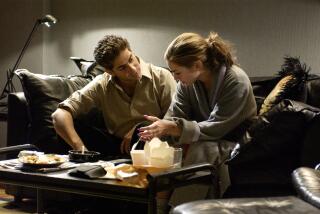Don’t Forget the Brutalized Women Behind ‘The Sopranos’
Well into its third season, television writers and critics nationwide continue to heap praise on HBO’s showpiece drama, “The Sopranos.” Widely hailed as breakthrough television, critics have regularly celebrated its characterizations of the gritty underbelly of gangster life. And while The Times has run a number of articles regarding the show’s Italian American stereotypes, nary a word has been uttered regarding its thoroughly regressive portrayals of women.
As long-suffering housewives, strippers and prostitutes, the women of “The Sopranos” take a beating--literally. The show’s psychological and physical violence against women reached its peak in the episode first televised April 1, when viewers were treated to the prolonged and fatal beating of a pregnant stripper. This episode followed closely on the heels of another in which Tony’s psychiatrist was brutally raped.
While positive portrayals of both men and women are in short supply on the drama, the show’s writers approach the development of male and female characters in decidedly different ways. The writers regularly invite us into Tony’s twisted internal world through flashbacks and therapy sessions. The resulting character is fully and inventively drawn, inviting understanding and sympathy from viewers. The writers make few such accommodations for “The Sopranos’ ” females. As one-dimensional characters, these women appear deserving of their less-than-desirable fates.
As strippers and prostitutes, the women of the Bada Bing club, a strip joint heavily frequented by Tony’s gang, merit and even expect the routine dismissals and degrading treatment received at the hands of their patrons. Until last week, when Tony’s long-suffering wife, Carmela, sought the help of a psychiatrist, she endured her husband’s extramarital affairs in steely silence, seemingly unwilling to take any action that might compromise her otherwise comfortable lifestyle.
The show’s writers give these psychologically and physically brutalized women no means of escape and yet no power. The female characters have no other choice than to look inward to divine how they may have contributed to their own sorry state.
Clearly, the show’s creators are trying to tell the tale of an unsavory group of mobsters and their troubled relationships with women. But the well-worn stereotypes of women as victims and sexual playthings represent a cop-out on the part of the show’s considerably talented behind-the-scenes staff.
Furthermore, every programming decision made by HBO (or any cable channel or network) is a considered choice. When HBO chooses to present “The Sopranos,” it chooses to showcase and glorify violence against women.
Of course, no program or network exists in a vacuum. The show merely highlights the existing misogynist tendencies of the television industry and society at large. (According to a study I conducted of the 1999-2000 season, women comprised a mere 23% of all creators, directors, writers, producers, editors and directors of photography working on network situation comedies and dramas.) In a culture that advocates and even celebrates “might makes right” in everything from global relations to capital punishment, it’s not surprising that such a program would receive critical acclaim.
Creator David Chase has publicly stated that he is uncertain about continuing the show into a fifth year. Here’s hoping he lets “The Sopranos” sleep with the fishes after next season.
*
Martha M. Lauzen is a professor in the school of communication at San Diego State. She conducts annual studies of women working in television and film.
More to Read
The complete guide to home viewing
Get Screen Gab for everything about the TV shows and streaming movies everyone’s talking about.
You may occasionally receive promotional content from the Los Angeles Times.






